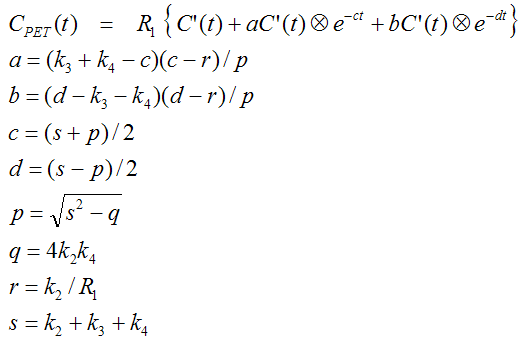The 4 parameter reference tissue method of Lammertsma et al. [28] requires two time-activity curves: one from a receptor-rich region and one from a reference region devoid of receptors. It then assumes that the distribution volume of the non-displaceable compartment is the same for the tissue of interest and the reference tissue: K1/k2=K1'/k2'
Defining R1=K1/K1' as the ratio of tracer delivery, and the binding potential BP as k3/k4, the following operational equation can be derived for the measured TAC in the receptor-rich region:

This equation includes four unknowns: R1, k2, k3, and BP (after substitution of BP=k3/k4) , which can be fitted using nonlinear fitting techniques.
Implementation Notes
After switching to the 4 Par Ref Tissue Model in PKIN a suitable reference region must be selected. For convolution with the exponentials, the reference tissue TAC is resampled on a regular grid, which can be specified by the resampling interval parameter in PKIN.
Abstract [28]
"Five different methods for the estimation of the binding potential, a measure of Bmax/Kd, of [11C]raclopride in human striatum were compared using data from a dose ranging study of the neuroleptic CP- 88,059-01. Binding potential was estimated indirectly, from distribution volumes in striatum and cerebellum, using both single- and two-tissue compartment models with a metabolite-corrected plasma curve as input function. The two-tissue compartment model was also used for a direct estimate of the binding potential. In addition, a direct estimate was obtained from the reference tissue compartment model using the cerebellum as indirect input function. Finally, an estimate of binding potential was calculated from the ratio of striatum over cerebellum counts at late times after injection. The estimates of striatum binding potential from all methods, except the direct determination using a two-tissue compartment model with metabolite-corrected plasma input function, correlated with each other. Use of an average metabolite correction resulted in only a small reduction in accuracy in this series of normal subjects. The reference tissue model provided estimates of the binding potential with the same sensitivity for detecting changes as those methods that required a metabolite-corrected plasma input function. This indicates that for routine analysis of clinical [11C]raclopride studies, no arterial cannulation is required. The range of normal values was significantly less variable with the reference tissue method than when simple striatum-to-cerebellum ratios were used."